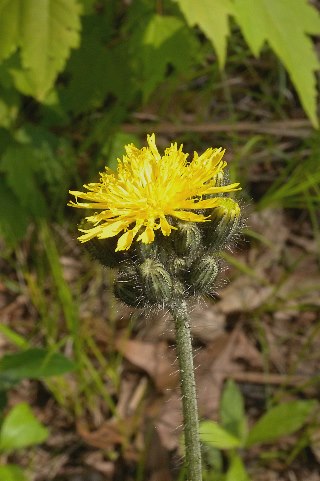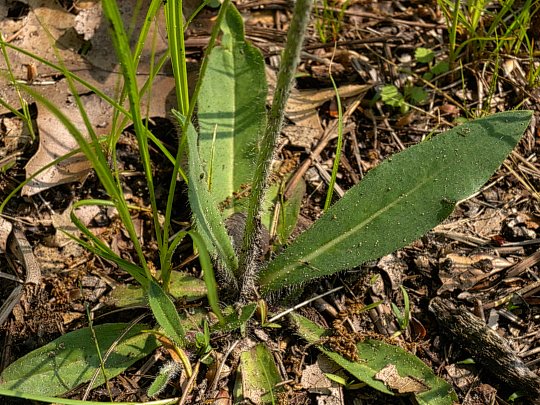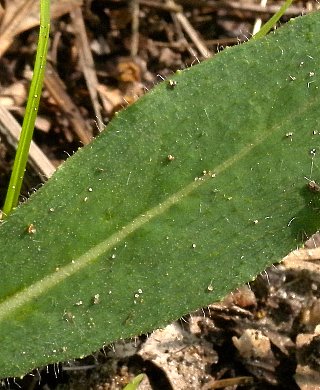 Description:
This perennial wildflower forms a low rosette of basal leaves, from
which a flowering stalk develops that is ½-2½' tall. The basal leaves
are 2-6" long and ½-1" across; they are oblanceolate or elliptic-oblong
in shape, while their margins are smooth and ciliate. The upper surface
of the
basal leaves is medium green and sparsely hairy, while the lower
surface is pale green and hairy. The flowering stalk is pale
green, terete, and unbranched; it has white hairs below and
glandular black hairs above. Sometimes there are 1-2 alternate leaves
along the lower half of its length. The alternate leaves are similar to
the basal leaves, except smaller in size. The flowering stalk
terminates in a dense cluster of 5-30 flowerheads. Each flowerhead is
½-¾" across, consisting of numerous yellow ray florets and their
reproductive organs. Individual petaloid rays are linear-oblong with 5
teeth at their truncate tips. At the base of each flowerhead, are
several floral bracts that are medium green and linear-oblong in shape;
they have glandular black hairs along their midveins. The branches of
the inflorescence are light green, terete, and glandular black-hairy.
The blooming period occurs from late spring to mid-summer for about 1
month. Afterwards, the florets are replaced by narrowly oblongoid
achenes about 1.5-2.0 mm. in length; the truncate upper tips of these
achenes have small tufts of white hair. The root system consists of a
taproot with either rhizomes or stolons. Occasionally, clonal offsets
develop to form small colonies of plants.
Description:
This perennial wildflower forms a low rosette of basal leaves, from
which a flowering stalk develops that is ½-2½' tall. The basal leaves
are 2-6" long and ½-1" across; they are oblanceolate or elliptic-oblong
in shape, while their margins are smooth and ciliate. The upper surface
of the
basal leaves is medium green and sparsely hairy, while the lower
surface is pale green and hairy. The flowering stalk is pale
green, terete, and unbranched; it has white hairs below and
glandular black hairs above. Sometimes there are 1-2 alternate leaves
along the lower half of its length. The alternate leaves are similar to
the basal leaves, except smaller in size. The flowering stalk
terminates in a dense cluster of 5-30 flowerheads. Each flowerhead is
½-¾" across, consisting of numerous yellow ray florets and their
reproductive organs. Individual petaloid rays are linear-oblong with 5
teeth at their truncate tips. At the base of each flowerhead, are
several floral bracts that are medium green and linear-oblong in shape;
they have glandular black hairs along their midveins. The branches of
the inflorescence are light green, terete, and glandular black-hairy.
The blooming period occurs from late spring to mid-summer for about 1
month. Afterwards, the florets are replaced by narrowly oblongoid
achenes about 1.5-2.0 mm. in length; the truncate upper tips of these
achenes have small tufts of white hair. The root system consists of a
taproot with either rhizomes or stolons. Occasionally, clonal offsets
develop to form small colonies of plants.Cultivation: The preference is full or partial sun, mesic to dry conditions, and slightly acidic sandy soil.
Range & Habitat: The non-native Field Hawkweed is rare in NE Illinois and largely absent from the rest of the state (see Distribution Map). It was introduced into North America from Europe. Habitats include dry sand prairies, upland sandy savannas, sandy pastures, abandoned fields, and waste areas. Sandy areas with a history of disturbance are preferred.

Faunal Associations: The flowerheads attract such visitors as bumblebees, other bees, butterflies, skippers, and Syrphid flies (Eastman, 1999). These floral visitors are attracted by either the nectar or pollen as a source of food. Hawkweeds (Hieracium spp.) are suspected host plants of Schinia bina (Bina Flower Moth). The larvae of this moth feed on the flowerheads of many plants in the Aster family. Vertebrate animals use hawkweeds as a source of food to a limited extent. The Ruffed Grouse and Wild Turkey feed on young leaves and seeds; a small songbird, the American Goldfinch, also eats the seeds. The Cottontail Rabbit, White-Tailed Deer, and Elk browse on the bitter foliage sparingly (Martin et al., 1951/1961). According to Georgia (1907), cattle avoid consumption of non-native hawkweeds.
Photographic Location: A sandy savanna at the Oak Openings Nature Preserve in NW Ohio.

Comments: Field Hawkweed is one of several native and non-native hawkweeds (Hieracium spp.) that can be found in Illinois. Like other non-native hawkweeds, this species has primarily basal leaves and very few, if any, cauline leaves. Field Hawkweed can be distinguished from other non-native hawkweeds by its dense cluster of flowerheads and the presence of hair on both sides of its basal leaves. Other non-native hawkweeds have flowerheads that are more widely spread out, or their basal leaves have hairs along the lower side only, or the branches of their inflorescences lack glandular black hairs. One non-native species that is found in Illinois, Hieracium aurantiacum (Orange Hawkweed), can be readily distinguished by its orange flowerheads. Another scientific name of Field Hawkweed is Hieracium pratense. This species is sometimes referred to as 'King Devil' or 'Yellow King Devil.' These are old farmer names that refer to its unwelcome persistence in pastures and agricultural fields.